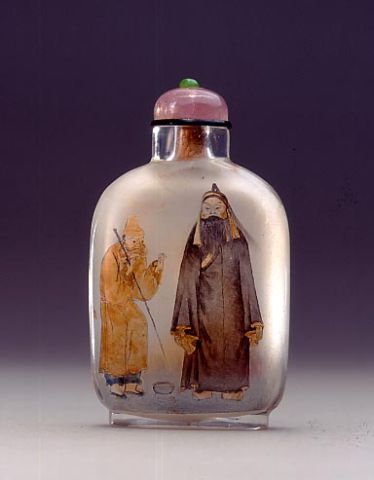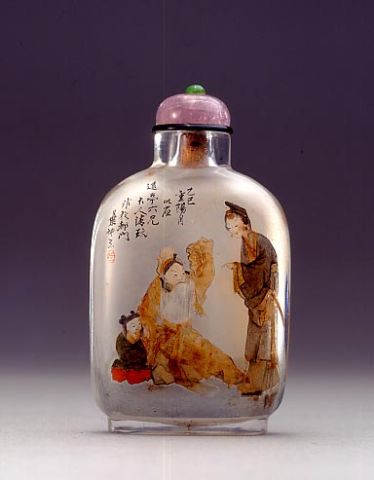

Bottle ID: 00913
YE ZHONGSAN, SCENES FROM OPERAS W/CHARACTERS
Date: October, 1905
Height: 61 mm
Glass, ink and watercolors, of flattened rectangular form with sloping shoulders, painted on one side with a scene from the Beijing opera, 'The Story of a Black Pot'; the other side with a scene from the opera 'Sanniang', 'Giving Guidance to the Orphan Boy', showing Xue Bao, an old family servant, mediating between a woman and her step-son; inscribed in draft script 'Made at the Capital, Ye Zhongsan, in the month of the Double Yang festival (Ninth Month, Ninth Day), the year yisi for the pure enjoyment of the honorable sixth elder brother Yuanting', with one seal Yin.
Similar Examples:
Provenance:
Asian Art Studio
Christie's, New York, March 30, 2005, lot 74
The J & J Collection
Hugh M. Moss Ltd.
Exhibited:
Annual Convention ICSBS Toronto, October 2007
Poly Art Museum, Beijing, 2003
International Asian Art Fair, Seventh Regiment Armory, New York, 2003
National Museum of History, Taipei, 2002
Portland Museum of Art, Oregon, 2002
Naples Museum of Art, Florida, 2002
Percival David Foundation of Chinese Art, London, 1997
Museum fur Kunsthandwerk, Frankfurt, 1996-1997
Empress Place Museum, Singapore, 1994
Christie's, New York, 1993
Hong Kong Museum of Art, October-December, 1978
Hugh M. Moss Ltd., London, September 1974
Published:
Moss, Hugh, Victor Graham and Ka Bo Tsang. The Art of the Chinese Snuff Bottle - The J & J Collection, Vol. 2, p. 715, no. 437
JICSBS, Autumn 1982, p. 38, figs. 95 and 95a
Snuff Bottles of the Ch'ing Dynasty, Hong Kong Museum of Art, 1978, pp. 122 and 138m, no. 227
JICSBS, September, 1975, pp. 3 and 4
This is a unique subject for Ye Zhongsan and one of his masterpieces. The striking figure in black robes in the scene from 'The Story of a Black Pot' proves Ye's capabilities as a portrait painter on a par with Ma Shaoxuan. Ye uses color in an accomplished way, creating figural compositions on both sides that are unusually strong and the subdued palette of colors, suddenly enlivened by the use of the brilliant vermilion, make this a tour de force. It is possible that Yuanting can be identified as Chang Yuanting (1860-1918), a prominent disciple of the Manchu, Wu Quanyou (1834-1902). Wu Quanyou was the founder of the Wu School of Taijiquan (Taiji Shadow Boxing). He came from an aristocratic Manchu family famous for its martial skills and became a banner-man during the Qing Dynasty.
< Back to full list
 English
English 中文
中文